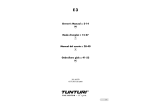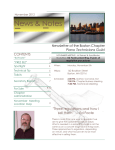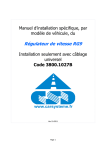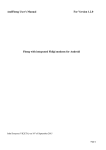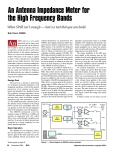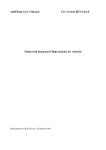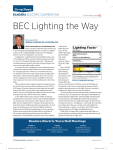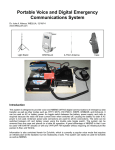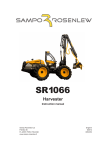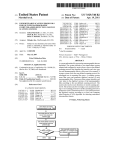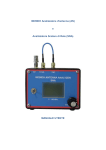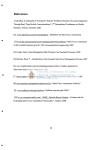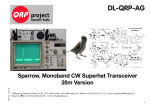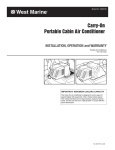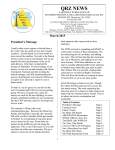Download The Chawed Rag-08-2013
Transcript
The Chawed Rag K5RWK UPCOMING EVENTS Meeting-on-the-Air Monday, August 5, 7:30 P.M. RWK Repeater, 2 Meters 147.120 (no PL Tone) Volume 43, Issue 8, August 2013 DX – a closer look ### Monthly Meeting Monday, August 12, 6:30 P.M. St. Barnabas Presbyterian Church 1220 W. Beltline Rd, Richardson DX – a closer look with Dick Morgan K6RAH, Hal Wolff N5BT, Jim Heye K5WLQ ### Monthly Breakfast Saturday, August 17, 8:00 A.M. Southern Recipe 1381 W. Campbell Rd. Richardson ### RACES Nets & Siren Test Monday, August 5, 9:00 P.M. (Net) Wednesday, August 7 Noon (SirenTest) Monday, August 19, 9:00 P.M. (Net) ### Dallas NBEMS Learning Net Every Thursday @ 7:30 P.M. 147.12 (no PL Tone) Affiliated Club Since 1952 Ham radio license exams rd 3 Thursday of each month @ 7:00 P.M. St. Barnabas Presbyterian Church Chasing DX combines the thrill of the hunt with unique operating techniques and a keen knowledge of radio propagation. Working other hams halfway around the globe is so much fun it becomes addicting! Three members will share their personal DX experience along with equipment ideas, helpful items you will want, and actual audio of some DX „pile ups‟ Hal Wolff encountered while working foreign DX stations on the HF bands at the end of July. Exchanging QSL cards with DX stations have different requirements, so you will hear some QSL tips that will help ensure that you receive that anxiously awaited confirmation from a rare DX entity directly or through the QSL bureau, LOTW, or a DX QSL manager. You will learn more about DXpeditions, how they are funded. You will learn what to expect when you finally get the chance to work a popular DXpedition. There also will be some time for questions at the end of the presentation. Come early and mingle. FREE coffee & cookies. Hey, bring a guest! Ham it up. In this issue: 1 K5RWK Upcoming Events 2 Prior meeting summary 3 RWK website & E-mail reflector information 3 Monthly Richardson sirens test 4 Future RWK events K5RWK Repeater 147.120/147.720 No tone needed - start talking! Prior meeting summary HF Antenna Tuning With Mac Cody AE5PH & Doug Knabe KN5DK Some hams just hang a length of wire out of the shack window. Others may try to load up their aluminum gutters or clamp a multi-band vertical to a convenient eave. Still other hams erect impressive towers and mount one or more rotatable Yagi beams. All need proper tuning to be effective. Experienced hams usually say to focus on improving your antenna system first, before considering a high power amplifier. The antenna helps in two ways. You will hear more stations with an enhanced antenna, and you get more punch when you are transmitting. Mac Cody displays his version of the ‘Tenna Dipper. Mac Cody, MSEE, demonstrated the theory and use of his “poor man‟s antenna analyzer,” the „Tenna Dipper, versus Doug‟s accurate miniVNA. The „Tenna Dipper proved to have a satisfactory accuracy and consistency for most antenna tuning requirements across several test bands. Although the theory is somewhat complex, the accuracy and low cost of a „Tenna Dipper make it an attractive alternative to more expensive units both for analyzing antennas, determining VSWR, resonant frequency, and gain patterns. tuning for maximum radiated signal. The original „Tenna Dipper, introduced by Steve Weber KD1JV, fit into an Altoids tin together with a 9 Volt battery! Later hybrid versions added more features. 39 members and guests attended. An original ‘Tenna Dipper in an Altoids tin. Mac discusses his ‘Tenna Dipper diagram. Carl Solomon (left) receives the Spark Award for Field Day. From a recent ARRL survey – Do you prefer to send paper QSLs to DX contacts directly or via the QSL Bureau system? Direct QSL Bureau I don’t send paper QSLs 49% 34% 17% 2013 Officers & Board Members President Frank Reisch RWK Website: http://www.k5rwk.org KG5LA 214.575.7866 V.P. & Program Coordinator Doug Knabe KN5DK 214.503.9357 Treasurer Doug Kilgore RWK E-mail: The Klub has a Yahoo group mailing list. Go to http://groups.yahoo.com/group/rwk-ntx/ KD5OUG 972.231.8539 Secretary Corey Minyard AE5KM Director Don Bowen RWK Web Page & E-mail Reflector Information K5LHO 972.414.7855 972.235.3063 Director Dave Russell W2DMR 972.690.9894 Director-Historian Hal Wolff N5BT 972.233.0345 Past President/Public Information Dick Morgan K6RAH 972.931.7993 Director Emeritus Forest Cummings W5LQU 972.231.0793 Repeater Chairman Doug Kilgore KD5OUG 972.231.8539 Repeater Trustee Carl Solomon W5SU 972.233.1233 Newsletter Editor Dick Morgan K6RAH 972.931.7993 The Chawed Rag is the official publication of The Richardson Wireless Klub, Inc. You may reproduce any material contained herein unless otherwise noted, with attribution to The Chawed Rag, original author(s), and The Richardson Wireless Klub, Inc. Please send us a complimentary copy for our files. Klub membership is open to all persons interested in amateur radio. Join at any meeting, by mail or on-line. Annual dues are $15 individual, $20 family, or $5 student rate. Archives of The Chawed Rag are available online at: http://k5rwk.org/index.php?option=com_ docman&Itemid=55 All Klub members are encouraged to subscribe. The E-mail list is a forum for announcements, comments and ideas of interest to members. Any Klub member on the list may post a message to the group at [email protected]. RWK Siren Testing Services The City of Richardson will test all emergency sirens on first Wednesdays, at noon (weather permitting). The test is not conducted if the weather looks threatening to avoid confusing residents. Hams assist each month by going to a designated siren, checking into the net on 147.12 MHz, watching and listening to the performance of the siren, then reporting on the net. Most sirens have an assigned ham, but there are a few unassigned sirens. Please contact Don Bowen K5LHO, 972.235.3063, if you can assist with siren tests near your QTH. Why “The Chawed Rag?” Ham radio operators love to talk! In addition to the many emergency communications services provided to their communities, hams enjoy chatting with fellow hams on the air. Hams exchange information about their locations, radio equipment they use, antennas and tuners, etc. Additionally, hams often discuss the weather and exchange personal and family information. With regular communications, they develop on-the-air friendships. Such discussions are characterized as “chewing the rag” with a friend or several friends over a network. That is the origin of this newsletter‟s strange name. Frankly, rag chewing with fellow hams is something that you must experience to appreciate. Ham radio is fun! If you want to explore amateur radio, contact one of our board members and join us at our monthly meetings. You are always welcome. Future RWK Events: Aug 05 – Monday – Meeting on the Air, 7:30 P.M. Aug 05 – Monday – Richardson RACES Net, 9:00 P.M. Aug 07– Wednesday – City of Richardson Siren Test, 12:00 noon http://www.cor.net/EM Aug 12 - Monday – Monthly Meeting, 6:30 P.M. – DX, a Closer Look Aug 15 – VE ham radio license exams, 7:00 P.M., St. Barnabas Presbyterian Church. Call 972.690.9894 Aug 17 – Saturday – Breakfast at Southern Recipe, 1381 W. Campbell Rd, Richardson – 8:00 A.M. Aug 19 – Monday – Richardson RACES Net, 9:00 P.M. Sep 02 – Monday – Meeting on the Air, 7:30 P.M. Sep 02 – Monday – Richardson RACES Net, 9:00 P.M. Sep 04– Wednesday – City of Richardson Siren Test, 12:00 noon http://www.cor.net/EM Sep 09 - Monday – Monthly Meeting, 6:30 P.M. – Sep 14 – Saturday – Breakfast at Southern Recipe, 1381 W. Campbell Rd, Richardson – 8:00 A.M. Sep 16 – Monday – Richardson RACES Net, 9:00 P.M. Sep 19 – VE ham radio license exams, 7:00 P.M., St. Barnabas Presbyterian Church. Call 972.690.9894 Oct 02– Wednesday – City of Richardson Siren Test, 12:00 noon http://www.cor.net/EM Oct 07 – Monday – Meeting on the Air, 7:30 P.M. Oct 07 – Monday – Richardson RACES Net, 9:00 P.M. Oct 14 - Monday – Monthly Meeting, 6:30 P.M. – Show & Tell Night Oct 17 – VE ham radio license exams, 7:00 P.M., St. Barnabas Presbyterian Church. Call 972.690.9894 Oct 19 – Saturday – Breakfast at Southern Recipe, 1381 W. Campbell Rd, Richardson – 8:00 A.M. Oct 21 – Monday – Richardson RACES Net, 9:00 P.M. Need help getting someone a ham license? Getting on the air? The Richardson Wireless Klub (RWK) donated to the Richardson Public Library a set of books to study for the Technician License. In addition, there are handbooks on various facets of ham radio operations. Look on the third floor in reference category 621.384. RWK now has several “loaner” HF and VHF transceivers available for short-term use by newly licensed RWK members. For more information, contact Dick Morgan ([email protected] or 972.931.7993). "Elmer" is the term used to identify a mentor for amateur radio. Here is a good online site with lots of references, self-study guides and video. http://www.hamelmer.com/. RWK members also act as local Elmers to new hams or members exploring new modes or interests. If you could use some help, just let us know. We will put you together with one of our ‘old hands’ to help get you going. There are interactive practice exams available online at the following websites: http://qrz.com/ht/, http://www.eham.net/exams/ or check out http://www.qrz.com/ht/. When you can consistently get a 90% or better on these practice exams, you are ready to take the real exam from one of our local club’s Volunteer Examiner teams. You can check for exam locations, dates, and times at http://www.arrl.org/exam_sessions/search. P.S. RWK offers exam sessions on the third Thursday of each month at 7:00 P.M. For more info, call Dave Russell at 972.690.9894. “QUA” (I HAVE NEWS OF…...) Plano Balloon Festival Special Event Station – K5P For the third year, the Plano Amateur Radio Klub (PARK) and McKinney ARC will jointly operate an Amateur Radio Special Event Station, with call sign K5P sanctioned by ARRL, at the 2013 Plano Balloon Festival. The station will be set up adjacent to the Balloon launch site in the parking lot of the First United Methodist Church, 3160 E. Spring Creek Parkway in Plano. The K5P event will run from 4:00 P.M. on Friday, Sept 20 until 4:00 P.M. on Sunday, Sept 22. The purpose of the Special Event Station is to showcase Amateur Radio to the public. It gives the public an opportunity to see how we operate on HF and VHF/UHF using voice, CW and digital, as well as demonstrating our support of the local community during emergencies. We invite all area clubs to join us at the event and help us in this worthy cause. It is an opportunity to meet members of other clubs and promote your club. Join us in making contacts across the country and around the world. The link for signing up for operating shifts is available at www.k5prk.net. Dallas NBEMS Learning Net Members of RWK sponsor the Dallas area Narrow Band Emergency Messaging System Learning Net each Thursday evening starting at 7:30 P.M. The net operates on the RWK 2-meter repeater at 147.12 MHz (no tone required). If you are interested in using narrow band mode for emergency communications, check into the net and “learn by doing.” For more information about NBEMS and the learning net, please contact Paul Newman KA5TYW at 972-437-5526, or Doug Kilgore KD5OUG at 972-231-8539. K5RWK VE Ham Exam sessions – Monthly Progress Report The Richardson Wireless Klub holds license exam sessions on the third Thursday evening each month! We examined six candidates in July. Three passed Technician exams. One tested for General and passed. One passed Extra Class, and one barely missed passing Extra Class. Thanks to the VEs who assisted with testing. Interested in becoming a VE? An open book orientation exam for Volunteer Examiners is all it takes to receive ARRL accreditation. If you are a General, Advanced, or Extra Class, why not get your accreditation? You don‟t even have to be accredited to be of help with greeting and other tasks! Attend an exam session soon and see for yourself how satisfying it can be to help conduct license exams. Dave is looking for more volunteers to help with sessions. For more information, contact Dave Russell W2DMR at 972.690.9894 or email [email protected]. Just for fun, since you’ve read this far… Retiree questions: > When is a retiree‟s bedtime? Two hours after he falls asleep in his chair. > How many days in a retiree‟s week? Six Saturdays, one Sunday! > How many retirees to change a light bulb? Only one, but it takes all day. > Among retirees, what is considered formal attire? Tied shoelaces. > What is the retiree‟s biggest gripe? Not enough time to get everything done! > What is the term for someone who enjoys work and refuses to retire? He‟s nuts! > What do retirees call a long lunch? Normal, of course. > What is the best way to describe retirement? A never-ending coffee break. > What is the advantage of going back to school? If you cut class, nobody calls your parents! > What do retirees do all week? Monday through Friday, nothing…then on Saturday and Sunday, they rest. HAM TRIVIA QUIZ According to CQ Magazine, which state has the most counties one must work in order to qualify for their USA-CA Award for working all counties? 1. 2. 3. 4. Pennsylvania California Texas Georgia From the Extra Class question pool What device is typically used as a stable reference voltage in a linear voltage regulator? A. B. C. D. A varactor diode A Zener diode An SCR A tunnel diode Copyright 2013, Richardson Wireless Klub K5RWK, Box 830232, Richardson, TX 75083. Answer to Extra Class Question: B Trivia Quiz: 3 New Ham - Article #6: Digital Communications What's all this Digital communications stuff anyway? What equipment will I need for digital communications modes such as packet? Will I need additional cables and antennas, or radios? If you have flipped through the 2 meter and 70 cm bands, you may have heard short burst of what sound like noise or modem tones. That is the sound of digital communications over the radio. Digital communications allow our computers to talk to each other in a binary language. The messages are broken up into short binary blocks or "packets.” A small amount of overhead information (such as your call sign) is added to the packets, and then it is transmitted over the air as audio tones. Why use digital communications at all? Isn't voice good enough? For many uses these days, the answer must be "No.” Computers in the shack are now as much a part of the ham shack as the radio, coax or power supply. We use them for everything from plotting a satellite's location to computerized logging of QSO's. Later, we want to transfer the file to someone else and when that time comes, it is easier to transfer that file by some form of digital communication. It is much better than using "sneaker net" where you put the file on disk, then put on your sneakers and run it over to another machine. To quote an instructor of mine: "I had the choice of whether or not to get involved with computers, my children will not, nor will yours." Even the conservative ARRL is on the Internet. Packet radio is keeping the ham spirit alive by giving us true WIRELESS digital communications. Chances are that you already have the computer and a radio (all the equipment needed to get started in Packet radio). The only additional equipment needed is the device that breaks up the data and converts this into audio. This device is a TNC or Terminal Node Controller. Prices range from about $100.00 for a simple packet mode only TNC to $500.00 plus for a multimode TNC. Other than that, the only additional software you might need is a terminal communications package such as ProComm or Crosstalk for DOS/Windows or Microphone or White Knight for the Macintosh. One important thing to remember about digital communications - as the bit rate goes up, so does the occupied Bandwidth. For this reason packet on HF is limited to 300 BPS. Packet on VHF and UHF where we have a larger spectrum of bandwidth can be 1200 BPS to 9600 BPS. Most TNCs have the ability to run both 300 and 1200 BPS, but depending on the manufacturer, running 300 BPS HF Packet may not be recommended. TNCs specifically meant to run HF Packet will have a tuning indicator on the front of the chassis to tune in the signal for optimum transmission. Because of the large bandwidth used at 9600 BPS packet, the radio must be have a larger receive and transmit IF bandpass for 9600 BPS. If you will look in any amateur radio magazine, you will probably see ads for radios listed as "9600 BPS Ready" meaning that these radios will work at 9600 BPS packet. Otherwise, you must modify the radio for the larger bandwidth required for 9600. One important thing to remember is that in packet radio, there are two sides of the TNC. The Radio side (the part connected to the radio) and the Terminal side (the part connected to the computer). The radio side will be limited to 300bps, 1200bps or 9600bps depending on the TNC you purchase. The terminal side will be limited to the highest speed your communications software can handle (300 to 19.2 kbps). Do not assume that because the radio side is running at 1200bps you have to run 1200bps on the terminal side. Interface cables between the radio and TNC usually have to be custom-manufactured by the TNC maker or the user. This is because of the wide variety of mike and speaker connections found on transceivers. Some manufactures such as MFJ make interface cables that you can buy to interface their TNC to the more popular radios. The literature that comes with the TNC usually will have a collection of drawings that show how to interconnect the TNC to a wide variety of radios. For this reason, if you are purchasing a previously owned TNC, be sure you are getting the user’s manual as well as the hardware. Packet radio used to be a real insiders game. Tweaking the software parameters on the TNC was something you had to know how to do or you needed to be in contact with a BBS (Bulletin Board System) operator who would talk you through the set up. [Bulletin board systems were in many ways a precursor to the modern form of the World Wide Web, social network services and other aspects of the Internet. Today, Internet forums occupy much of the same social and technological space as BBS’s did, and the term BBS often is used to refer to any online forum or message board. - Wikipedia] Now that the packet standards have firmed up, and the manufactures are making the TNCs with a complete standard set of commands, the packet radio is pretty much a "Plug and Play" affair (other than a calibration setup to set the Transmit and Receive levels). If you are even remotely involved with computers, enjoy the world of WIRELESS digital communications. 73’s and GL Gerry WD4BIS Copyright 2005 Gerald Crenshaw WD4BIS. All rights are reserved. Permission in advance is granted to those who use this for non-profit Amateur Radio club newsletters as long as it is used unmodified including this copyright notice and that notice is given to the author via email [email protected]). In addition, please forward a copy of any newsletter this appears in to: Gerry Crenshaw WD4BIS, c/o GARC, 1027B W. Austin St, Garland, TX, 75040









